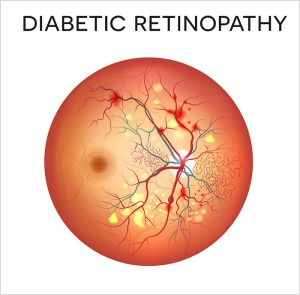
Diabetic retinopathy is the most common cause of irreversible blindness in working-age Americans. Diabetic retinopathy occurs in more than half the people who develop diabetes. Several factors influence whether you get retinopathy such as: blood sugar control, blood pressure levels, how long you have had diabetes, and your genes. Your retina can be badly damaged before you notice any change in vision. For this reason, you should have your eyes examined regularly by an eye care professional. There are two major types of retinopathy: nonproliferative and proliferative.
In nonproliferative retinopathy, the most common form of retinopathy, capillaries in the back of the eye become blocked and they balloon and form pouches which can leak fluid into the retina. Nonproliferative retinopathy can move through three stages (mild, moderate, and severe) as more blood vessels become blocked.
Macular edema
The capillary walls may lose their ability to control the passage of substances between the blood and the retina. Fluid can leak into the macula, the central part of the eye where focusing occurs. When the macula swells with fluid, vision blurs and can be lost entirely. Although nonproliferative retinopathy usually does not require treatment, macular edema must be treated. Fortunately treatment is usually effective at stopping and sometimes reversing vision loss.
Proliferative retinopathy
In some people, retinopathy progresses to a more serious form called proliferative retinopathy. In this form, the blood vessels are so damaged they close off. In response, new blood vessels start growing in the retina. These new vessels are weak and can bleed into the eye, completing blocking vision. The new blood vessels can also cause scar tissue to grow. This scar tissue contracts and can pull on the retina causing retinal detachment.
How is it Treated?
Huge strides have been made in the treatment of diabetic retinopathy. Treatments with medications injected into the eye can often reverse changes from diabetic retinopathy and can improve macular edema and proliferative retinopathy. Additionally, supplemental laser treatments can help stabilize the retina. In some severe cases, a surgical procedure called a vitrectomy can help restore vision. The sooner retinopathy is diagnosed, the more likely these treatments will be successful. The best results occur when sight is still normal.
